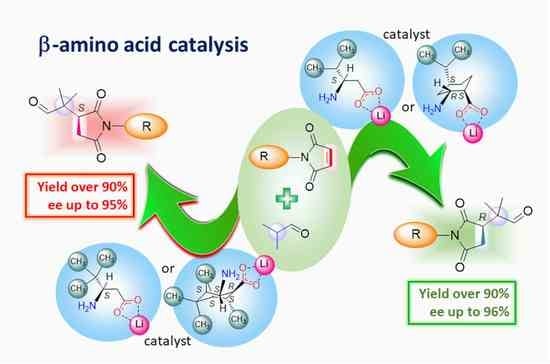β-Amino Acid Organocatalysts in the Asymmetric Michael Addition of Isobutyraldehyde to N-Substituted Maleimides
Abstract
:1. Introduction
2. Results
3. Discussion
4. Materials and Methods
5. Conclusions
Author Contributions
Funding
Data Availability Statement
Conflicts of Interest
References
- Šunjić, V.; Parnham, M.J. Signposts to Chiral Drugs, Organic Synthesis in Action; Springer Basel AG: Basel, Switzerland, 2011. [Google Scholar] [CrossRef]
- Lin, G.-Q.; You, Q.-D.; Cheng, J.-F. (Eds.) Chiral Drugs, Chemistry and Biological Action; John Wiley & Sons, Inc.: Hoboken, NJ, USA, 2011. [Google Scholar]
- Busacca, C.A.; Fandrick, D.R.; Song, J.J.; Senanayake, C.H. The Growing Impact of Catalysis in the Pharmaceutical Industry. Adv. Synth. Catal. 2011, 3535, 1825–1864. [Google Scholar] [CrossRef]
- Nag, A. (Ed.) Asymmetric Synthesis of Drugs and Natural Products; CRC Press, Taylor & Francis Group: Boca Raton, FL, USA, 2018. [Google Scholar]
- Mikami, K.; Lautens, M. (Eds.) New Frontiers in Asymmetric Catalysis; John Wiley & Sons: Hoboken, NJ, USA, 2007. [Google Scholar]
- Ojima, I. (Ed.) Catalytic Asymmetric Synthesis, 3rd ed.; John Wiley & Sons: Hoboken, NJ, USA, 2010. [Google Scholar]
- Gruttadauria, M.; Giacalone, F. (Eds.) Catalytic Methods in Asymmetric Synthesis: Advanced Materials, Techniques and Applications; John Wiley & Sons: Hoboken, NJ, USA, 2011. [Google Scholar]
- Szőllősi, G. Asymmetric One-Pot Reactions Using Heterogeneous Chemical Catalysis: Recent Steps Towards Sustainable Processes. Catal. Sci. Technol. 2018, 8, 389–422. [Google Scholar] [CrossRef]
- Pellissier, H. Asymmetric Metal Catalysis in Enantioselective Domino Reactions; Wiley-VCH Verlag: Weinheim, Germany, 2019. [Google Scholar]
- Pellissier, H. Recent Developments in Enantioselective Multicatalyzed Tandem Reactions. Adv. Synth. Catal. 2020, 362, 2289–2325. [Google Scholar] [CrossRef]
- Pellissier, H. Recent Developments in Asymmetric Organocatalysis; RSC Catalysis Series No. 3; RSC Publishing: Cambridge, UK, 2010. [Google Scholar]
- Giacalone, F.; Gruttadauria, M.; Agrigento, P.; Noto, R. Low-loading Asymmetric Organocatalysis. Chem. Soc. Rev. 2012, 41, 2406–2447. [Google Scholar] [CrossRef] [PubMed]
- Dalko, P.I. (Ed.) Comprehensive Enantioselective Organocatalysis: Catalysts, Reactions, and Applications; Wiley-VCH: Weinheim, Germany, 2013; Volumes 1–3. [Google Scholar]
- Xiao, X.; Shao, B.-X.; Lu, Y.-J.; Cao, Q.-Q.; Xia, C.-N.; Chen, F.-E. Recent Advances in Asymmetric Organomulticatalysis. Adv. Synth. Catal. 2021, 363, 352–387. [Google Scholar] [CrossRef]
- Juaristi, E. Recent Developments in Next Generation (S)-Proline-derived Chiral Organocatalysts. Tetrahedron 2021, 88, 132143. [Google Scholar] [CrossRef]
- Córdova, A. (Ed.) Catalytic Asymmetric Conjugate Reactions; Wiley-VCH: Weinheim, Germany, 2010. [Google Scholar]
- Vicario, J.L.; Badia, D.; Carrillo, L.; Reyes, E. (Eds.) Organocatalytic Enantioselective Conjugate Addition Reactions, A Powerful Tool for the Stereocontrolled Synthesis of Complex Molecules; RSC Catalysis Series No. 5; RSC Publishing: Cambridge, UK, 2010. [Google Scholar]
- Namboothiri, I.N.N.; Bhati, M.; Ganesh, M.; Hosamani, B.; Bajiu, T.V.; Manchery, S.; Bera, K. Catalytic Asymmetric Reactions of Conjugated Nitroalkenes; CRC Press, Taylor & Francis Group: Boca Raton, FL, USA, 2020. [Google Scholar]
- Crider, A.M.; Kolczynski, T.M.; Yates, K.M. Synthesis and Anticancer Activity of Nitrosourea Derivatives of Phensuximide. J. Med. Chem. 1980, 23, 324–326. [Google Scholar] [CrossRef]
- Fredenhagen, A.; Tamura, S.Y.; Kenny, P.T.M.; Komura, H.; Naya, Y.; Nakanishi, K.; Nishiyama, K.; Sugiura, M.; Kita, H. Andrimid, a New Peptide Antibiotic Produced by an Intracellular Bacterial Symbiont Isolated from a Brown Planthopper. J. Am. Chem. Soc. 1987, 109, 4409–4411. [Google Scholar] [CrossRef]
- Curtin, M.L.; Garland, R.B.; Heyman, H.R.; Frey, R.R.; Michaelides, M.R.; Li, J.; Pease, L.J.; Glaser, K.B.; Marcotte, P.A.; Davidsen, S.K. Succinimide Hydroxamic Acids as Potent Inhibitors of Histone Deacetylase (HDAC). Bioorg. Med. Chem. Lett. 2002, 12, 2919–2923. [Google Scholar] [CrossRef]
- Freiberg, C.; Brunner, N.A.; Schiffer, G.; Lampe, T.; Pohlmann, J.; Brands, M.; Raabe, M.; Häbich, D.; Ziegelbauer, K. Identification and Characterization of the First Class of Potent Bacterial Acetyl-CoA Carboxylase Inhibitors with Antibacterial Activity. J. Biol. Chem. 2004, 279, 26066–26073. [Google Scholar] [CrossRef]
- Isaka, M.; Rugseree, N.; Maithip, P.; Kongsaeree, P.; Prabpai, S.; Thebtaranonth, Y. Hirsutellones A–E, Antimycobacterial Alkaloids from the Insect Pathogenic Fungus Hirsutella nivea BBC 2594. Tetrahedron 2005, 61, 5577–5583. [Google Scholar] [CrossRef]
- Uddin, J.; Ueda, K.; Siwu, E.R.O.; Kita, M.; Uemura, D. Cytotoxic Labdane Alkaloids from an Ascidian Lissoclinum sp.: Isolation, Structure Elucidation, and Structure-Activity Relationship. Bioorg. Med. Chem. 2006, 14, 6954–6961. [Google Scholar] [CrossRef] [PubMed]
- Chauchan, P.; Kaur, J.; Chimni, S.S. Asymmetric Organocatalytic Addition Reactions of Maleimides: A Promising Approach Towards the Synthesis of Chiral Succinimide Derivatives. Chem. Asian J. 2013, 8, 328–346. [Google Scholar] [CrossRef] [PubMed]
- Bartoli, G.; Bosco, M.; Carlone, A.; Cavalli, A.; Locatelli, M.; Mazzanti, A.; Ricci, P.; Sambri, L.; Melchiorre, P. Organocatalytic Asymmetric Conjugate Addition of 1,3-Dicarbonyl Compounds to Maleimides. Angew. Chem. Int. Ed. 2006, 45, 4966–4970. [Google Scholar] [CrossRef] [PubMed]
- Huang, X.; Yi, W.-B.; Ahad, D.; Zhang, W. Recyclable Cinchona Alkaloid Catalyzed Asymmetric Michael Addition Reaction. Tetrahedron Lett. 2013, 54, 6064–6066. [Google Scholar] [CrossRef]
- Mahajan, S.; Chauhan, P.; Kumar, A.; Chimni, S.S. Organocatalytic Enantioselective Synthesis of N-Alkyl/Aryl-3-Alkylpyrrolidine-2,5-dione in Brine. Tetrahedron Asymmetry 2016, 27, 1145–1152. [Google Scholar] [CrossRef]
- Zhao, G.-L.; Xu, Y.; Sundén, H.; Eriksson, L.; Sayah, M.; Córdova, A. Organocatalytic Enantioselective Conjugate Addition of Aldehydes to Maleimides. Chem. Commun. 2007, 734–735. [Google Scholar] [CrossRef]
- Wang, J.; Zhang, M.-M.; Zhang, S.; Xu, Z.-A.; Li, H.; Yu, X.-H.; Wang, W. Chiral Pyrrolidine Sulfonamide Catalyzed Enantioselective Michael Addition of Cyclohexanones to Maleimides. Synlett 2011, 2011, 473–476. [Google Scholar] [CrossRef]
- Yu, F.; Sun, X.; Jin, Z.; Wen, S.; Liang, X.; Xe, J. Enantioselective Michael Addition of Ketones to Maleimides Catalyzed by Bifunctional Monosulfonyl DPEN Salt. Chem. Commun. 2010, 46, 4589–4591. [Google Scholar] [CrossRef]
- Yu, F.; Jin, Z.; Huang, H.; Ye, T.; Liang, X.; Ye, J. A Highly Efficient Asymmetric Michael Addition of α,α-Disubstituted Aldehydes Catalysed by Primary Amine Thiourea Salt. Org. Biomol. Chem. 2010, 8, 4767–4774. [Google Scholar] [CrossRef]
- Xue, F.; Liu, L.; Zhang, S.; Duan, W.; Wang, W. A Simple Primary Amine Thiourea Catalyzed Highly Enantioselective Conjugate Addition of α,α-Disubstituted Aldehydes to Maleimides. Chem. Eur. J. 2010, 16, 7979–7982. [Google Scholar] [CrossRef] [PubMed]
- Bai, J.-F.; Peng, L.; Wang, L.-L.; Wang, L.-X.; Xu, X.-Y. Chiral Primary Amine Thiourea Promoted Highly Enantioselective Michael Reactions of Isobutyraldehyde with Maleimides. Tetrahedron 2010, 66, 8928–8932. [Google Scholar] [CrossRef]
- Miura, T.; Nishida, S.; Masuda, A.; Tada, N.; Itoh, A. Asymmetric Michael Additions of Aldehydes to Maleimides Using a Recyclable Fluorous Thiourea Organocatalyst. Tetrahedron Lett. 2011, 52, 4158–4160. [Google Scholar] [CrossRef]
- Gómez-Torres, E.; Alonso, D.A.; Gómez-Bengoa, E.; Nájera, C. Conjugate Addition of 1,3-Dicarbonyl Compounds to Maleimides Using a Chiral C2-Symmetric Bis(2-aminobenzimidazole) as Recyclable Organocatalyst. Org. Lett. 2011, 13, 6106–6109. [Google Scholar] [CrossRef]
- Avila, A.; Chinchilla, R.; Nájera, C. Enantioselective Michael Addition of α,α-Disubstituted Aldehydes to Maleimides Organocatalyzed by Chiral Primary Amine-Guanidines. Tetrahedron Asymmetry 2012, 23, 1625–1627. [Google Scholar] [CrossRef]
- Gómez-Torres, E.; Alonso, D.A.; Gómez-Bengoa, E.; Nájera, C. Enantioselective Synthesis of Succinimides by Michael Addition of 1,3-Dicarbonyl Compounds to Maleimides Catalyzed by a Chiral Bis(2-aminobenzimidazole) Organocatalyst. Eur. J. Org. Chem. 2013, 1434–1440. [Google Scholar] [CrossRef]
- Avila, A.; Chinchilla, R.; Gómez-Bengoa, E.; Nájera, C. Enantioselective Synthesis of Succinimides by Michael Addition of Aldehydes to Maleimides Organocatalyzed by Primary Amine-Guanidines. Eur. J. Org. Chem. 2013, 2013, 5085–5092. [Google Scholar] [CrossRef]
- Nakashima, K.; Kawada, M.; Hirashima, S.; Kato, M.; Koseki, Y.; Miura, T. Asymmetric Conjugate Addition of Ketones to Maleimides Using Diaminomethyleneindenedione Organocatalyst. Synlett 2015, 26, 1248–1252. [Google Scholar] [CrossRef]
- Vízcaíno-Milla, P.; Sansano, J.M.; Nájera, C.; Fiser, B.; Gómez-Bengoa, E. Primary Amine–2-Aminopyrimidine Chiral Organocatalysts for the Enantioselective Conjugate Addition of Branched Aldehydes to Maleimides. Synthesis 2015, 47, 2199–2206. [Google Scholar] [CrossRef]
- Nakashima, K.; Kawada, M.; Hirashima, S.; Kosugi, A.; Kato, M.; Yoshida, A.; Koseki, Y.; Miura, T. Stereoselective Conjugate Addition of Carbonyl Compounds to Maleimides Using a Diaminomethyleneindenedione Organocatalyst. Tetrahedron Asymmetry 2016, 27, 888–895. [Google Scholar] [CrossRef]
- Torregrosa-Chinillach, A.; Moragues, A.; Pérez-Furundarena, H.; Chinchilla, R.; Gómez-Bengoa, E.; Guillena, G. Enantioselective Michael Addition of Aldehydes to Maleimides Organocatalyzed by a Chiral Primary Amine-Salicylamide. Molecules 2018, 23, 3299. [Google Scholar] [CrossRef] [PubMed]
- Szőllősi, G.; Kozma, V. Design of Heterogeneous Organocatalyst for the Asymmetric Michael Addition of Aldehydes to Maleimides. ChemCatChem 2018, 10, 4362–4368. [Google Scholar] [CrossRef]
- Kozma, V.; Fülöp, F.; Szőllősi, G. 1,2-Diamine-Derived (thio)Phosphoramide Organocatalysts in Asymmetric Michael Additions. Adv. Synth. Catal. 2020, 362, 2444–2458. [Google Scholar] [CrossRef]
- Kozma, V.; Szőllősi, G. Conjugate Addition of 1,3-Dicarbonyl Compounds to Maleimides Using Bifunctional Primary Amin–(thio)Phosphoramide Organocatalysts. Mol. Catal. 2022, 518, 112089. [Google Scholar] [CrossRef]
- Grünenfelder, C.E.; Kisunzu, J.K.; Wennemers, H. Peptide-Catalyzed Stereoselective Conjugate Addition Reactions of Aldehydes to Maleimides. Angew. Chem. Int. Ed. 2016, 55, 8571–8574. [Google Scholar] [CrossRef] [PubMed]
- Avila-Ortiz, C.G.; Díaz-Corona, L.; Jiménez-González, E.; Juraisti, E. Asymmetric Michael Addition Organocatalyzed by α,β-Dipeptides under Solvent-Free Reaction Conditions. Molecules 2017, 22, 1328. [Google Scholar] [CrossRef]
- Nugent, T.C.; Sadiq, A.; Bibi, A.; Heine, T.; Zeonjuk, L.L.; Vankova, N.; Bassil, B.S. Noncovalent Bifunctional Organocatalysts: Powerful Tools for Contiguous Quaternary-Tertiary Stereogenic Carbon Formation, Scope, and Origin of Enantioselectivity. Chem. Eur. J. 2012, 18, 4088–4098. [Google Scholar] [CrossRef]
- Kokotos, C.G. An Asymmetric Michael Addition of α,α-Disubstituted Aldehydes to Maleimides Leading to a One-Pot Enantioselective Synthesis of Lactones Catalysed by Amino Acids. Org. Lett. 2013, 15, 2406–2409. [Google Scholar] [CrossRef]
- Schiza, A.; Spiliopoulou, N.; Shahu, A.; Kokotos, C.G. Combining Organocatalysis with Photoorganocatalysis: Photocatalytic Hydroacylation of Asymmetric Organocatalytic Michael Addition Products. New J. Chem. 2018, 42, 18844–18849. [Google Scholar] [CrossRef]
- Sadiq, A.; Nugent, T.C. Catalytic Access to Succinimide Products Containing Stereogenic Quaternary Carbons. ChemistrySelect 2020, 5, 11934–11938. [Google Scholar] [CrossRef]
- Ahmad, S.; Mahnashi, M.H.; Alyami, B.A.; Alqahtani, T.S.; Ullah, F.; Ayaz, M.; Tariq, M.; Sadiq, A.; Rashid, U. Synthesis of Michael Adducts as Key Building Blocks for Potential Analgesic Drugs: In vitro, in vivo and in silico Explorations. Drug Des. Dev. Ther. 2021, 15, 1299–1313. [Google Scholar] [CrossRef]
- Muramulla, S.; Ma, J.-A.; Zhao, J.C.-G. Michael Addition of Ketones and Aldehydes to Maleimides Catalysed by Modularly Designed Organocatalysts. Adv. Synth. Catal. 2013, 355, 1260–1264. [Google Scholar] [CrossRef]
- Landeros, J.M.; Cruz-Hernández, C.; Juaristi, E. α-Amino Acids and α,β-Dipeptides Intercalated into Hydrotalcite: Efficient Catalysts in the Asymmetric Michael Addition Reaction of Aldehydes to N-Substituted Maleimides. Eur. J. Org. Chem. 2021, 2021, 5117–5126. [Google Scholar] [CrossRef]
- Kozma, V.; Szőllősi, G. Enantioselective Michael Addition of Aldehydes to Maleimides Catalysed by Surface-Adsorbed Natural Amino Acids. Catal. Sci. Technol. 2022, 12, 4709–4726. [Google Scholar] [CrossRef]
- Zhang, H.; Mifsud, M.; Tanaka, F.; Barbas, C.F., III. 3-Pyrrolidinecarboxylic Acid for Direct Catalytic Asymmetric anti-Mannich-Type Reactions of Unmodified Ketones. J. Am. Chem. Soc. 2006, 128, 9630–9631. [Google Scholar] [CrossRef] [PubMed]
- Yang, H.; Wong, M.W. β-Amino Acid Catalyzed Asymmetric Michael Additions: Design of Organocatalysts with Catalytic Acid/Base Dyad Inspired by Serine Proteases. J. Org. Chem. 2011, 76, 7399–7405. [Google Scholar] [CrossRef]
- Konda, S.; Zhao, J.C.-G. Enantioselective anti-Mannich Reaction Catalysed by Modularly Designed Organocatalysts. Tetrahedron 2018, 74, 6166–6172. [Google Scholar] [CrossRef] [PubMed]
- Byrne, F.P.; Jin, S.; Paggiola, G.; Petchey, T.H.M.; Clark, J.H.; Farmer, T.J.; Hunt, A.J.; McElroy, C.R.; Sherwood, J. Tools and Techniques for Solvent Selection: Green Solvent Selection Guides. Sustain. Chem. Process. 2016, 4, 7. [Google Scholar] [CrossRef]
- Flores-Ferrándiz, J.; Chinchilla, R. Solvent-Dependent Enantioswitching in the Michael Addition of α,α-Disubstituted Aldehydes to Maleimides Organocatalyzed by mono-N-Boc-Protected Cyclohexa-1,2-diamines. Tetrahedron Asymmetry 2014, 25, 1091–1094. [Google Scholar] [CrossRef] [Green Version]
- Szakonyi, Z.; Martinek, T.A.; Sillanpää, R.; Fülöp, F. Regio- and Stereoselective Synthesis of the Enantiomers of Monoterpene-Based β-Amino Acid Derivatives. Tetrahedron Asymmetry 2007, 18, 2442–2447. [Google Scholar] [CrossRef]
- Szakonyi, Z.; Martinek, T.A.; Sillanpää, R.; Fülöp, F. Regio- and Stereoselective Synthesis of Constrained Enantiomeric β-Amino Acid Derivatives. Tetrahedron Asymmetry 2008, 19, 2296–2303. [Google Scholar] [CrossRef]
- Szakonyi, Z.; Balázs, Á.; Martinek, T.A.; Fülöp, F. Stereoselective Synthesis of Pinane-Based β- and γ-Amino Acids via Conjugate Addition of Lithium Amides and Nitromethane. Tetrahedron Asymmetry 2010, 21, 2498–2504. [Google Scholar] [CrossRef]
- Szakonyi, Z.; Sillanpää, R.; Fülöp, F. Stereoselective Synthesis of Perillaldehyde-Based chiral β-Amino Acid Derivatives through Conjugate Addition of Lithium Amides. Beilstein J. Org. Chem. 2014, 10, 2738–2742. [Google Scholar] [CrossRef] [PubMed] [Green Version]
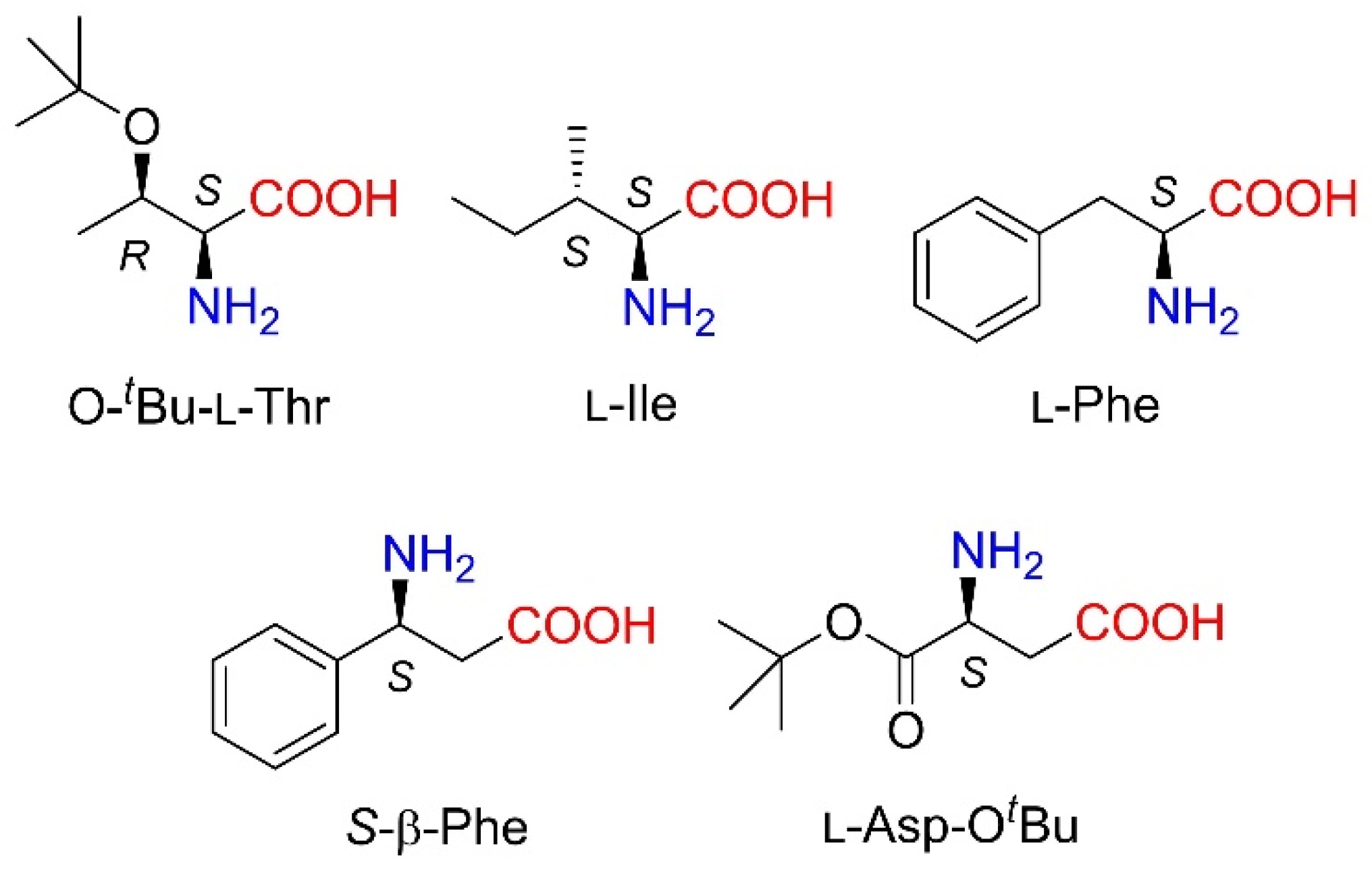

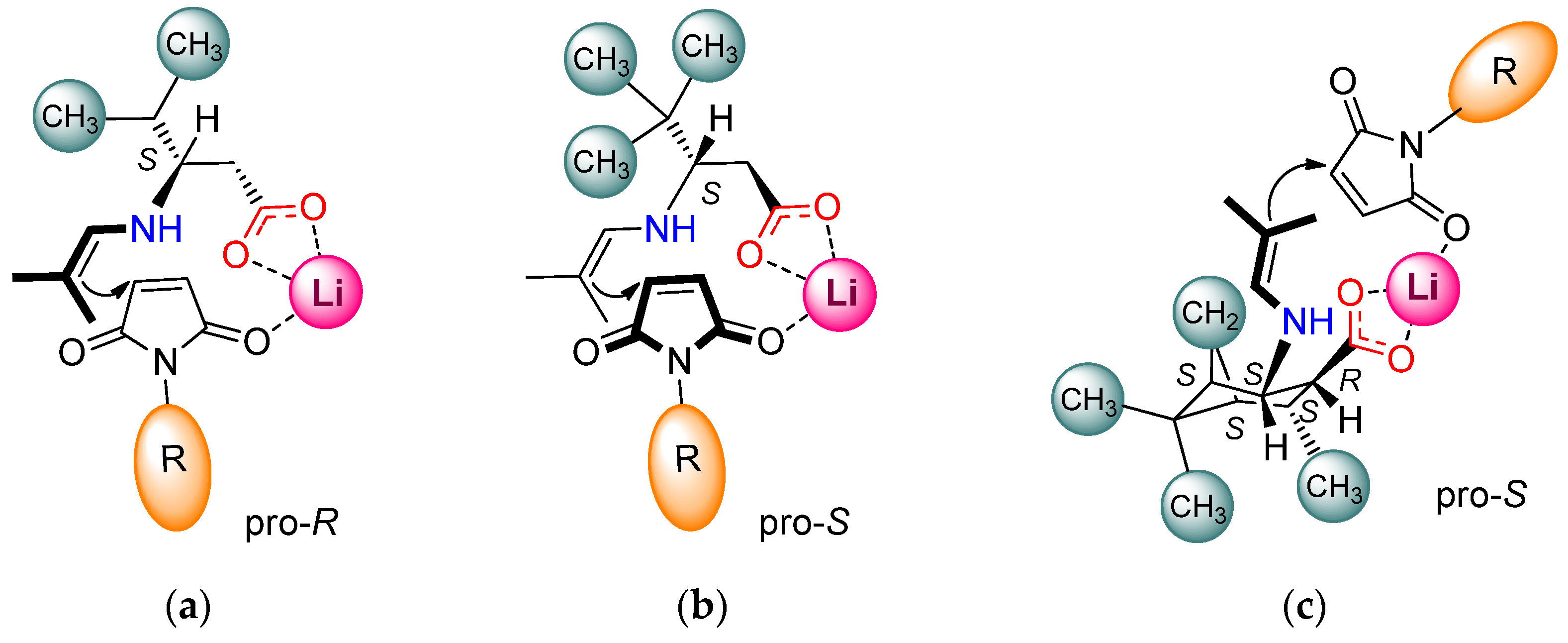
| Entry | Amount of 4 (mol%) | Additive b | Solvent; Amount (cm3) | Time (h) | Conv (%) c | ee (%) d |
|---|---|---|---|---|---|---|
| 1 | 10 | – | EtOAc; 1 | 16 | 12 | 73 |
| 2 | 10 | Cs2CO3 | EtOAc; 1 | 16 | 85 | 73 |
| 3 | 10 | KOH | EtOAc; 1 | 16 | >99 | 87 |
| 4 | 10 | LiOH × H2O | EtOAc; 1 | 16 | >99 | 95 |
| 5 | 10 | LiOH × H2O | CH2Cl2; 1 | 16 | 98 | 95 |
| 6 | 10 | LiOH × H2O | tBuOMe; 1 | 16 | >99 | 94 |
| 7 | 10 | LiOH × H2O | MeCN; 1 | 16 | >99 | 93 |
| 8 | 10 | LiOH × H2O | (Me)2CO; 1 | 16 | 95 (99 e) | 92 |
| 9 | 10 | LiOH × H2O | iPrOH; 1 | 16 | >99 | 78 |
| 10 | 10 | LiOH × H2O | MeOH; 1 | 16 | 52 | 50 |
| 11 | 5 | LiOH × H2O | EtOAc; 1 | 16 | 84 | 95 |
| 12 | 2.5 | LiOH × H2O | EtOAc; 1 | 16 | 50 | 95 |
| 13 | 10 | LiOH × H2O | EtOAc; 1 | 6 | 80 | 95 |
| 14 f | 10 | LiOH × H2O | EtOAc; 1 | 6 | 98 | 92 |
| 15 | 10 | LiOH × H2O | EtOAc; 2 | 16 | 94 | 95 |
| 16 | 5 | LiOH × H2O | EtOAc; 2 | 16 | 55 | 95 |
| 17 | 5 | LiOH × H2O | EtOAc; 0.5 | 16 | 87 | 94 |
| Entry | Catalyst | LiOH × H2O Amount (eq) b | Temp. (°C) | Time (h) | Conv (Yield) (%) c | ee (%) (config.) d |
|---|---|---|---|---|---|---|
| 1 |  | – | 24 | 16 | 12 (nd) | 73 (R) |
| 2 | 1.5 | 24 | 16 | >99 (91) | 95 (R) | |
| 3 | 1.5 | 50 | 6 | 98 (90) | 92 (R) | |
| 4 |  | – | 24 | 16 | 47 (nd) | 24 (S) |
| 5 | 1.5 | 24 | 16 | 97 (88) | 81 (S) | |
| 6 | 1.5 | 50 | 6 | 88 (80) | 78 (S) | |
| 7 |  | – | 24 | 16 | 35 (nd) | 84 (R) |
| 8 | 1.5 | 24 | 16 | 91 (81) | 94 (R) | |
| 9 | 1.5 | 24 | 24 | >99 (92) | 94 (R) | |
| 10 | 1.5 | 50 | 6 | 74 (nd) | 94 (R) | |
| 11 |  | – | 24 | 16 | 18 (nd) | 91 (S) |
| 12 | 1.5 | 24 | 16 | 32 (nd) | 94 (S) | |
| 13 e | 1.5 | 24 | 48 | >99 (93) | 95 (S) | |
| 14 | 1.5 | 50 | 24 | 81 (70) | 94 (S) |
| Entry | Catalyst | LiOH × H2O Amount (eq) b | Temp. (°C) | Time (h) | Conv (Yield) (%) c | ee (%) (config.) d |
|---|---|---|---|---|---|---|
| 1 e | 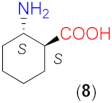 | – | 24 | 16 | 47 (nd) | 52 (R) |
| 2 | – | 24 | 24 | 76 (66) | 51 (R) | |
| 3 e | – | 50 | 24 | 84 (75) | 49 (R) | |
| 4 e | 1.5 | 24 | 16 | >99 (92) | 82 (S) | |
| 5 e | 1.5 | 50 | 6 | 99 (90) | 82 (S) | |
| 6 | 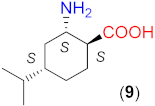 | – | 24 | 24 | 63 (nd) | 37 (S) |
| 7 | 2.2 | 24 | 24 | 95 (87) | 65 (S) | |
| 8 | 2.2 | 50 e | 6 | 77 (66) | 61 (S) | |
| 9 | 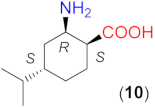 | – | 24 | 24 | 52 (nd) | 60 (R) |
| 10 | 2.2 | 24 | 24 | >99 (91) | 93 (R) | |
| 11 | 2.2 | 50 | 24 | >99 (92) | 94 (R) | |
| 12 | 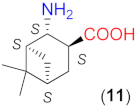 | – | 24 | 44 | 56 (nd) | 64 (R) |
| 13 | – | 24 | 96 | 91 (80) | 62 (R) | |
| 14 | – | 50 | 24 | 83 (75) | 61 (R) | |
| 15 | 2.2 | 24 | 72 | 88 (79) | 14 (S) | |
| 16 | 2.2 | 50 | 24 | 77 (65) | 10 (S) | |
| 17 | 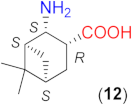 | – | 24 | 44 | 10 (nd) | 36 (S) |
| 18 | 2.2 | 24 | 24 | 72 (63) | 87 (S) | |
| 19 | 2.2 | 24 | 44 | >99 (90) | 88 (S) | |
| 20 | 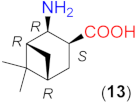 | – | 50 | 24 | 37 (nd) | 40 (R) |
| 21 | 2.2 | 24 | 24 | 68 (60) | 95 (R) | |
| 22 | 2.2 | 50 | 24 | 88 (77) | 92 (R) | |
| 23 | 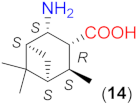 | – | 24 | 24 | 29 (nd) | 11 (S) |
| 24 | 2.2 | 24 | 24 | 95 (86) | 92 (S) | |
| 25 | 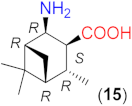 | – | 24 | 24 | 14 (nd) | 14 (R) |
| 26 | 2.2 | 24 | 24 | 96 (88) | 94 (R) |
 | |||
|---|---|---|---|
| Entry | Product | Conv (Yield) (%) c | ee (%) (config.) d |
| 1 | 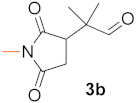 | 92 (85) | 95 (R) |
| 2 b | 93 (85) | 92 (S) | |
| 3 | 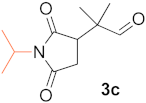 | 97 (90) | 96 (R) |
| 4 | 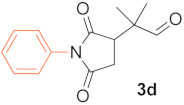 | >99 (93) | 96 (R) |
| 5 b | >99 (92) | 95 (S) | |
| 6 | 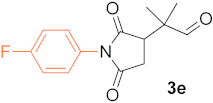 | 99 (92) | 93 (R) |
| 7 | 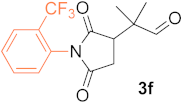 | 99 (93) | 95 (R) |
Publisher’s Note: MDPI stays neutral with regard to jurisdictional claims in published maps and institutional affiliations. |
© 2022 by the authors. Licensee MDPI, Basel, Switzerland. This article is an open access article distributed under the terms and conditions of the Creative Commons Attribution (CC BY) license (https://creativecommons.org/licenses/by/4.0/).
Share and Cite
Kozma, V.; Szakonyi, Z.; Szőllősi, G. β-Amino Acid Organocatalysts in the Asymmetric Michael Addition of Isobutyraldehyde to N-Substituted Maleimides. Catalysts 2022, 12, 992. https://doi.org/10.3390/catal12090992
Kozma V, Szakonyi Z, Szőllősi G. β-Amino Acid Organocatalysts in the Asymmetric Michael Addition of Isobutyraldehyde to N-Substituted Maleimides. Catalysts. 2022; 12(9):992. https://doi.org/10.3390/catal12090992
Chicago/Turabian StyleKozma, Viktória, Zsolt Szakonyi, and György Szőllősi. 2022. "β-Amino Acid Organocatalysts in the Asymmetric Michael Addition of Isobutyraldehyde to N-Substituted Maleimides" Catalysts 12, no. 9: 992. https://doi.org/10.3390/catal12090992
APA StyleKozma, V., Szakonyi, Z., & Szőllősi, G. (2022). β-Amino Acid Organocatalysts in the Asymmetric Michael Addition of Isobutyraldehyde to N-Substituted Maleimides. Catalysts, 12(9), 992. https://doi.org/10.3390/catal12090992







